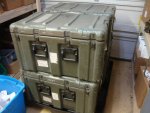...One bit of advice I would offer is to make sure they are attached to something that can act as a heatsink...
Indeed, I'm killing two birds with one stone here - since PWM is the generation of an AC waveform and I'm driving enough current to illuminate power LEDs, a long strip of AC waveform makes an antenna... If not shielded.

The 1/2" wide strips come with a 3M VHB clear acrylic tape, this will be used during assembly to temporarily attach the strip to the center of a 4"-wide
100-mesh copper screen backing. Over the face of the LED strip (the emitting side), a 3/4" wide strip of frosted vinyl will be heat laminated to the LED strip and the edge of the copper mesh backing. Over the top of that will be a 4-3/4" wide strip of 22-mesh copper screen, with a half round relief rolled in for the strip - this will be sewn on along the heat sealed edge of the frosted facing to bind the front screen and back screen with
tinned 38AWG copper wire (like a thread). Every 1/8" along the sewn border and at the edge of the two screens a solder dot will electrically and thermally bind the two screen halves - this will mean that the heat dissipating surface is increased by a factor of 8. The back will then get a
heat/light reflective faced vinyl sheet, and the front a
clear fiber reinforced vinyl face - then will be heat sealed to each other, which will melt the vinyl through the copper screen making it a solid/monolithic structure, and will water seal the assembly. Finally the white back of the light panel will have two strips of 2" Velcro sewn on with nylon thread. The two strips of Velcro (instead of one wide one) will create a small but effective air gap between the light strip and the inside of the tent liner. Two wired connector cables will come out the center of the long axis of the strip perpendicular to the length of the strip - I'm designing these so that they can be individually replaced and moved around, and the light controller (in the rack) will learn the new layout automatically allowing for quick simple setup. I intend to publish the design files here in case anyone want to try to replicate it.
Finally, the strip is not the most powerful one I could have obtained, and as you can see above by the algorithm, only half of the LED dies in each package (cool or warm white) can be 100% active at a time. Note that this tent would be VERY bright if they were turned up to 100% - a 305 Base-X has about 450 square feet of floor, one roll of this LED strip is 3175lumens with the warm white illuminated (less output that the cool white), 5-rolls (one roll per 5' section of tent) at 100% warm white would give me just shy of 16,000 lumens - that's ~35.25 lumens per square foot of floor (about 380lux). That's brighter than most classrooms/offices during the day, and approaching laboratory lighting levels. Cool white will give me "Showroom" brightness levels.
The central controller is planned to have a max level control for white and green (separately). The knob will set limits and the battery level cause the controller to taper of the output as the battery level falls, to eek out as much run-time as can be managed. In the end I should have full control from NVIS-compatible 1lux, all the way up to an "illuminating" 450lux (couldn't help myself

).
The whole thing wrapped in copper mesh acts as a
Faraday Cage, and with shielded cables, power filters on the supply and differential signalling for the control (extra shield and twisted pair), it should be electrically/RF quiet too.









